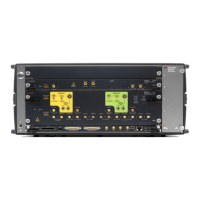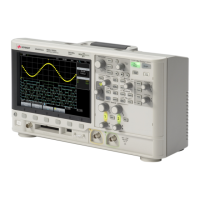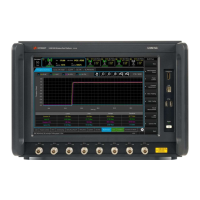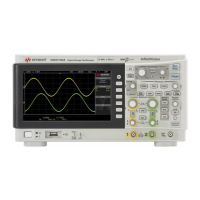Keysight M8000 Series of BER Test Solutions User Guide 513
Working with Measurements 8
Characterization
Table 71 Characterization
Name Description
Algorithm Search algorithms apply to characterization measurements only.
Name Description
Binary The Binary algorithm uses a variable step size to find the highest
passing SJ amplitude at each SJ frequency in the template.
Starting at the maximum SJ amplitude determined by the upper
limit in the template file or the instrument limit, whichever is
lower, followed by the minimum SJ amplitude determined by the
lower limit in the template file, the Binary algorithm then sets
subsequent SJ amplitudes at the logarithmic midpoint between
the highest passing and lowest failing SJ amplitudes. A test point
is determined to be a passing point if the BER measured is below
the BER threshold set by the user.
The equation for the midpoint (c) between points a and b on a log
scale is:
c = 10^((log(a) + log(b)) / 2).
The algorithm exits if the channel is tolerant of the maximum jitter
amplitude or is intolerant of the minimum jitter amplitude.
Otherwise, the algorithm continues until the last step size is less
than the minimum step size set by the user for Binary algorithms.
The jitter tolerance result at each jitter modulation frequency is
the highest jitter amplitude at which the measurement was made
below the threshold BER. However, if the device is intolerant of
even the minimum jitter value, the result is not valid and is not
plotted.
In many cases, the Binary algorithm is the quickest. However,
devices with hysteresis may not have consistent results when
using the Binary algorithm since the approach direction (up vs.
down) will cause the result to vary. This occurs because the PLL in
the clock data recovery unit will typically hold lock longer as the
jitter is increased, then it would establish lock as the jitter is
reduced. For example, a receiver may have a higher passing SJ
amplitude when the previous step was a lower (passing) SJ
amplitude, compared to a lower passing SJ amplitude when the
previous step was a higher (failing) SJ amplitude. If this is a
problem, see the Binary + Down Linear and Binary + Up Linear
algorithms.

